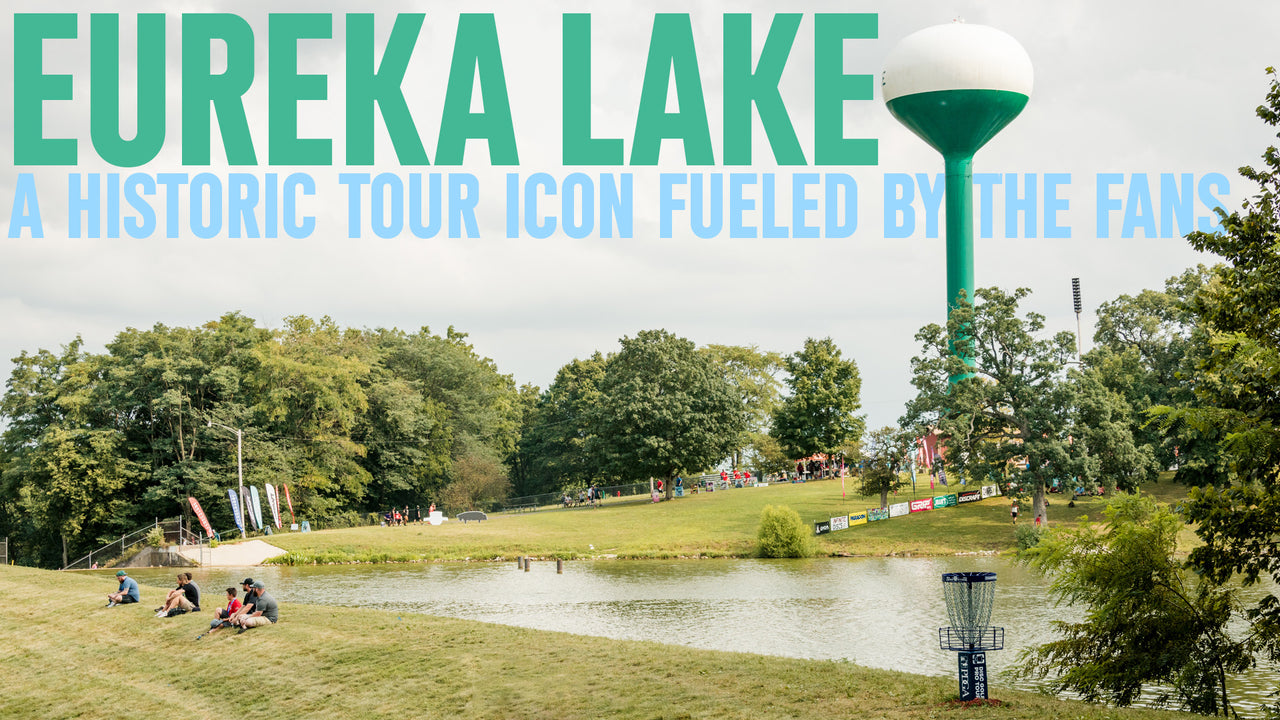Every August, the population in Eureka, Illinois doubles.
The city’s main attraction, a large municipal park surrounding a 30-acre reservoir known as Eureka Lake, is host to the annual Ledgestone Open. Thousands flock to the park to watch the best disc golfers in the world tackle one of the sport’s iconic courses.
The course, known as Eureka Temp, only exists during the tournament week each year and has been showcased for less than a decade. However, the history of disc golf on site goes back much further.
We took the time to sit down with Ledgestone Open tournament director and course designer, Nate Heinold, to unpack how the sport has grown at Lake Eureka Park and what changes ultimately led to the current iteration of Eureka Temp that fans and players have come to know and love.
Not long after the successful installation of the first disc golf course at Northwood Park in Morton, local course designer Greg Nettles pitched another possible course location, this time in the small city of Eureka. The project was approved for the wooded section in the northeast portion of Lake Eureka Park.
Nettles and a team of assistants (including Heinold) installed the course and opened it to the public in 2004. Now known as “Eureka Perm”, it is still the only full-time course on the property.
For the next decade, nothing changed.
Then, in early 2015, a few days after the Ledgestone Open amateur registration had filled up in a matter of minutes and the waitlist continued to grow, Heinold found himself driving past Lake Eureka Park with thoughts of expansion.
“I stopped and stood by the water tower and looked out over the park,” he said. “I thought to myself that I needed to find a way to use the property for the amateur side.”
Heinold reached out to the city with an initial design idea and, recognizing the size and reputation of the Ledgestone Open, they quickly approved it.
“We had worked with the city for years on the permanent course, so they were at least aware of disc golf,” he said. “I pitched them on the tourism, but it was relatively easy to convince them to let us do it because back then we were only using temporary rubber tee pads and temporary baskets. There was no actual construction.”
However, when he was going through the finalization of the course layout, Heinold had a change of heart.
“As I went through the design, I realized I wanted to throw it into the MPO mix,” he said.
Heinold’s initial MPO design made its debut at the 2015 Ledgestone Open as the featured Final 9 course. Simon Lizotte, Paul McBeth, Nate Doss, Cameron Colglazier, and Johne McCray showcased a portion of the layout to the world for the first time.
Though the hole numbers have since changed, a few of the hole ideas from the first iteration of Eureka Temp can still be found on the course today with a few tweaks. Holes 1 and 18 remain, along with iconic tee shots like the baseball field, bridge, and water tower holes (though out-of-bounds lines have been changed).
The spectator turnout at Eureka Temp to watch the 2015 Final 9 was so great that it wasn’t until the 2019 PDGA World Championships in Peoria that a larger crowd was on site. The upside to the attendance was instrumental to the course’s growth.
“The city got to see the benefit of the temporary course pretty quickly,” Heinold said.
This led to the approval of permanent tee pads and cemented sleeves for the baskets which debuted in 2018. This was also the same year for another major change at Eureka: the official removal of stroke and distance OB rules.
During the first several years of the Ledgestone Open, instead of proceeding to a drop zone after throwing OB, players would take a penalty stroke and rethrow from their previous lie until they successfully landed in bounds.
“The PDGA never liked it,” Heinold explained. “But in 2015, when Simon won and gave himself the nickname ‘Simon Lays Up’ instead of ‘Simon Lizotte’, I realized I didn’t want to see Simon lay up shots. Nobody is paying to see that.”
Other changes have been incorporated throughout the years at Eureka to make the course flow better and to provide more challenge to the players. The 2015 spectator turnout helped Heinold gain permission to use the southwest portion of the park, bringing in the addition of holes 13 through 17 several years later.
In 2017, hole 2 - which was previously two separate holes - was combined into a well-received par 4. This helped open the door for another change one year later when the area between the iconic bridge hole and the water tower was moved from one singular hole to two par 3s.
Since 2018, the course has remained relatively unchanged apart from a few OB rope maneuvers and basket positions shifting by a few feet.
“The design we have now is very strong and statistically strong,” Heinold said. “I don’t foresee a lot of changes over the next few years.”
One change that fans and players will continue to see each year is the brand-new, custom-wrapped ChainstarPro baskets from Discraft. Donated each year by the Michigan manufacturer, these baskets are raffled off after the tournament to raise money for the St. Jude Children’s Research Hospital.
Following the tournament each year, a group of volunteers (made up mainly by the local football team) drives around and pulls each basket from the ground. In less than a day, Lake Eureka Park is back to normal for fishing, walking, and hanging out.




